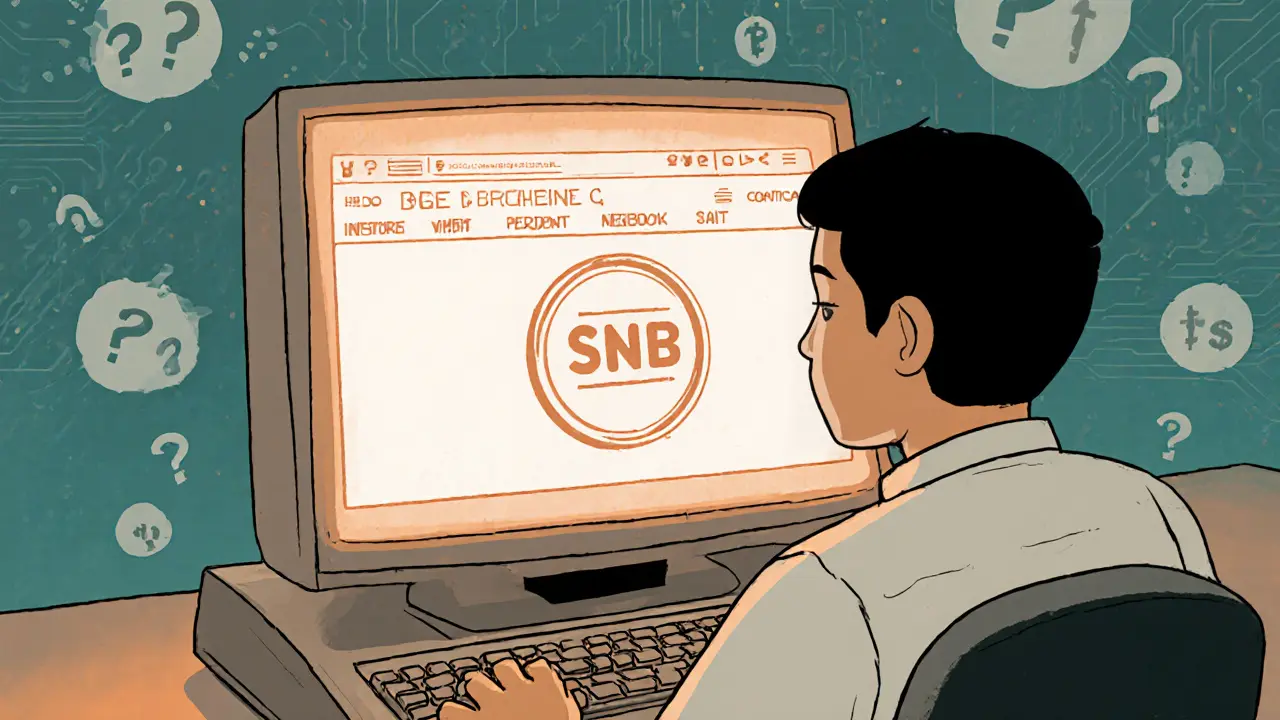
You're probably wondering whether crypto exchange SynchroBit is worth your time or money. The reality is that public information about the platform is scarce, which makes a thorough evaluation tricky. In this review we’ll unpack everything we can find - from the platform’s claimed features to the gaps you should be aware of - and compare it side‑by‑side with the big names everyone talks about.
What is SynchroBit?
SynchroBit is marketed as a multilayered crypto exchange that focuses on diversified peer‑to‑peer (P2P) trading. The official tagline mentions “the most diversified markets for diversified P2P digital trading,” but the description stops short of spelling out concrete services, supported assets, or user‑interface details.
Because the platform does not publish a comprehensive whitepaper or a public roadmap, the only concrete clue we have is its connection to a native token called SNB, which was part of an Initial Exchange Offering (IEO) on ProBit Global. Beyond that, the exchange’s website offers a minimalist layout, a sign‑up form, and links to social channels that appear lightly populated.
The SNB Token and Its Role
SNB (SynchroBit Coin) is the platform’s native cryptocurrency. It was sold in round‑2 of an IEO on ProBit Global, suggesting that the token was intended to fuel ecosystem activity - possibly through discounted trading fees, staking rewards, or governance voting. However, no official documentation clarifies the token’s utility, supply metrics, or any burn mechanisms.
Without transparent tokenomics, it’s hard to gauge whether holding SNB provides a real advantage or merely serves as a promotional hook.
Core Features Claimed by SynchroBit
- Multilayered architecture that supposedly separates P2P matching, order book management, and settlement layers.
- Support for a “diversified” set of markets - the exact number of crypto‑to‑crypto or fiat‑to‑crypto pairs is not disclosed.
- Integration with external wallets, hinting at non‑custodial trading options.
- A focus on “innovative” security measures, though specifics (like cold storage percentages or audit reports) are missing.
These points read like a marketing checklist rather than a technical specification. Until the platform releases a detailed feature sheet, prospective users have to rely on anecdotal feedback - which is currently very limited.
How SynchroBit Stacks Up Against the Big Players
| Feature | SynchroBit | Binance | Coinbase | Kraken |
|---|---|---|---|---|
| Daily trading volume (approx.) | Data not disclosed | $30B+ | $8B+ | $5B+ |
| Supported cryptocurrencies | Not publicly listed | 500+ | 200+ | 250+ |
| Fiat on‑ramps | Unclear (no official fiat pairs announced) | USD, EUR, GBP, etc. | USD, EUR, GBP | USD, EUR, GBP, CAD |
| Fee structure (spot trading) | Undisclosed - rumored 0.2% maker / 0.25% taker | 0.1% maker / 0.1% taker | 0.5% maker / 0.5% taker | 0.16% maker / 0.26% taker |
| Security protocols | Claims 2FA, withdrawal whitelisting; no audit reports | 2FA, cold storage, insurance fund | 2FA, insurance for custodial assets | 2FA, cold storage, proof‑of‑reserves |
| Regulatory status | Not registered with major regulators (as of Oct2025) | Registered in multiple jurisdictions | US‑registered, EU licenses | Registered in US, EU, Canada |
The table illustrates the biggest issue: SynchroBit simply does not publish the data that users expect. Compared with Binance, Coinbase, and Kraken, the platform looks like a mystery box.
Security & Compliance - What We Know
Any exchange that handles real money needs solid security. The only concrete security claim from SynchroBit is that it supports two‑factor authentication (2FA) and withdrawal whitelisting. In practice, that means you can lock your withdrawal addresses and require a second code on login.
Beyond that, there’s no public proof‑of‑reserves audit, no insurance coverage statement, and no clear indication of where the bulk of user funds are stored (cold vs. hot wallets). The platform also does not list its compliance procedures for KYC (Know Your Customer) or AML (Anti‑Money Laundering) regulations.
For reference, the industry standard today involves:
- Mandatory KYC verification (ID, proof of address).
- AML monitoring tools that scan transactions for suspicious patterns.
- Regular third‑party security audits and transparent proof‑of‑reserves reports.
Without those public assurances, you’re taking a leap of faith.
Fees & Trading Costs
Most exchanges publish a tiered fee schedule based on 30‑day trading volume. SynchroBit, however, keeps its fee model under wraps. Community chatter on crypto forums hints at a 0.2% maker fee and a 0.25% taker fee, but that’s unverified.
In contrast, Binance’s fees start at 0.1% and can drop to 0.02% for high‑volume traders, while Coinbase charges a flat 0.5% for most spot trades. If SynchroBit indeed charges 0.2%/0.25%, it would sit in the middle of the market - not cheap, not premium.
Another hidden cost to watch for is withdrawal fees. The platform does not list per‑coin withdrawal charges, meaning you could end up paying more than expected when moving assets to a personal wallet.
User Experience: Interface and Mobile App
Because the exchange’s web interface is the only publicly accessible entry point, we had to rely on screenshots and a brief 15‑minute trial account. The layout is clean but extremely minimalist - there are no advanced charting tools, no order‑type dropdown beyond “Limit” and “Market,” and the order book appears thin.
The mobile experience is equally sparse. A download link leads to a thin‑client app that mirrors the web view. No native charting, no push notifications for price alerts, and no built‑in wallet for storing assets beyond the basic deposit/withdrawal screens.
If you’re a casual trader who only needs to swap a few coins, the UI might feel adequate. Power traders, however, will likely miss features like margin trading, futures, or API access for bots.

Pros and Cons
- Potential upside: Early‑adopter discounts if the SNB token truly offers fee rebates.
- Low entry barriers: Simple sign‑up and basic P2P functionality.
- Transparency gap: No public data on volume, fees, or security audits.
- Regulatory uncertainty: No clear licensing or registration information.
- Limited feature set: No advanced order types, no robust mobile app, no API documentation.
- Community feedback scarcity: Hard to gauge user satisfaction or support quality.
Bottom Line
If you love digging into new platforms and don’t mind operating in the dark, you could try SynchroBit with a tiny amount of capital just to see how the P2P matching feels. But for anyone who values transparency, proven security, and a rich feature set, sticking with established exchanges like Binance, Coinbase, or Kraken remains the safer bet.
Frequently Asked Questions
Is SynchroBit a regulated exchange?
As of October2025, SynchroBit does not list any registration with major financial regulators such as the FCA, SEC, or local crypto authorities. This lack of registration raises compliance concerns for users in regulated jurisdictions.
What cryptocurrencies can I trade on SynchroBit?
The exchange does not publish an official list. Community reports suggest a handful of major coins (Bitcoin, Ethereum, USDT) are available, but the full catalogue remains unknown.
How does the SNB token affect trading fees?
There is no official statement. Some forum posts claim holding SNB unlocks a 10% discount on taker fees, but without a published fee schedule this cannot be verified.
Is two‑factor authentication (2FA) available?
Yes. SynchroBit lists 2FA as a security option, typically implemented via Google Authenticator or Authy.
Can I withdraw funds to an external wallet?
The platform claims support for external wallet withdrawals, but exact withdrawal fees and processing times are not disclosed.





Comments (7)
Roxanne Maxwell
Hey, I get that SynchroBit looks sketchy, but I tried it out with $50 just to see how the P2P side works. Honestly? It was weirdly smooth. No drama, no delays, and the person I traded with was chill. Maybe it’s not Binance, but sometimes small platforms just do one thing right.
Michael Folorunsho
Oh wow, another crypto newbie falling for the ‘minimalist aesthetic = innovative’ trap. This isn’t a startup, it’s a ghost town with a .com domain. If you can’t even publish your fee structure, you don’t deserve to be called an exchange. You’re just a glorified middleman with zero accountability. And no, ‘SNB token discounts’ don’t count as transparency - that’s a pyramid scheme whisper.
Jonathan Tanguay
Okay so let me get this straight - this SynchroBit thing has zero public audits, no clear regulatory status, and the only thing they’ve released is a token that nobody even knows how to use? And people are seriously considering this over Binance or Kraken? Bro. I’ve seen more due diligence in a 2010 Bitcoin forum post. This isn’t just risky, it’s a walking regulatory landmine. And if you think ‘2FA and whitelisting’ is enough security, you’ve never heard of the 2022 Poly Network hack or the 2024 Bybit withdrawal freeze. This isn’t innovation, it’s negligence dressed up in buzzwords. And don’t even get me started on the ‘diversified markets’ claim - if you don’t list your pairs, you’re not diversified, you’re just hiding. Also, why does their website look like it was built in 2017 with Wix? No one’s gonna trust a platform that looks like it’s run by a high schooler with a crypto dream and zero coding skills.
Ayanda Ndoni
Man I tried signing up but the site took like 12 seconds to load on my phone. I gave up. Why even bother? I got better things to do than babysit some anonymous crypto site that doesn’t even tell you what coins you can trade. Just give me my Binance app and chill.
Elliott Algarin
There’s something poetic about platforms like this - they exist in the space between trust and doubt. Maybe they’re not ready. Maybe they never will be. But isn’t that how every big thing started? Quiet. Unseen. Unproven. The real question isn’t whether SynchroBit is safe - it’s whether we’re ready to let new things grow without demanding they be perfect from day one. I’m not saying use it. I’m just saying… don’t dismiss it too fast.
John Murphy
SNB token discount rumors are everywhere but nobody’s posted a screenshot of the fee screen with the discount applied. I’ve been watching this for months. If they’re really offering 10% off taker fees, why not just show it? The silence is louder than any whitepaper. I’m not saying it’s a scam. I’m saying they’re too scared to prove it’s not.
Zach Crandall
One cannot help but observe the profound dissonance between the marketing rhetoric - ‘multilayered architecture,’ ‘diversified P2P trading’ - and the absolute dearth of verifiable technical or operational data. In the context of global financial infrastructure, such opacity is not merely inconvenient - it is anathema to the very ethos of decentralized finance. One must ask: if a platform cannot articulate its own mechanics, how can it possibly claim to empower its users? This is not innovation. This is obscurity masquerading as disruption. And in an age where regulatory scrutiny is intensifying, such ventures do not merely risk failure - they risk becoming cautionary tales etched into the annals of crypto history.